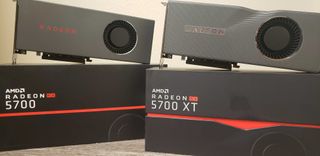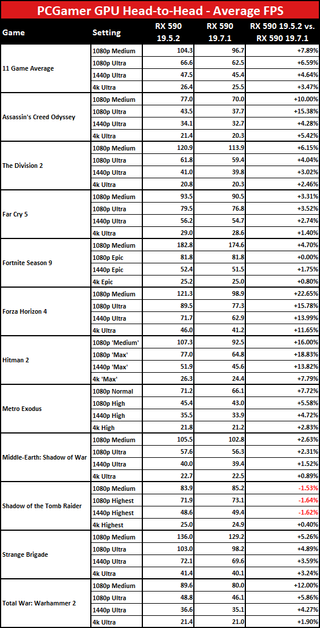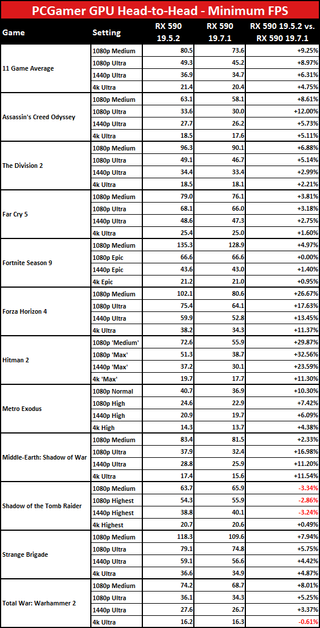Revisiting AMD's 19.7.1 drivers and the RX 5700 launch
A closer look at AMD's 19.7.1 drivers and an explanation for the RX 5700's sometimes questionable performance.

[Update: There are many factors that can affect performance, particularly when looking at just one system. Taking the time to retest 11 games with new drivers isn't something we normally do, but the RX 5700 performance was questionable enough that I decided to check out one specific older GPU. I selected the RX 590 because it represents a good median point in AMD's product stack.
The 19.7.1 drivers were already installed (for the 5700 testing), and after completing those benchmarks I did a clean install of the 19.5.2 drivers. I've since rechecked performance in a few games with 19.7.1 after doing a clean install. Some of the dips noted above went away (Forza Horizon 4, Metro Exodus), but RX 5700 performance in Shadow of War remains a problem. (AMD is aware of this issue and is working on a fix.)
If you're experiencing any odd performance issues with the latest drivers, I highly recommend doing a complete GPU drivers wipe using Display Driver Uninstaller, reboot, and then update to the latest drivers.
Original text follows.]
Earlier this week, AMD launched its new Radeon RX 5700 XT and Radeon RX 5700. While the cards in general perform well enough, there were enough oddities that we delayed our initial reviews a few days. After further investigation, it appears AMD shot itself in the foot a bit with its latest drivers. I'm going to look at the Radeon RX 590 specifically for this piece, mostly because I needed to use an existing card and I wanted to confirm some of the performance numbers.
Let me give a bit of background information to get everyone up to speed. The RX 5700 cards—both models—performed about as expected in most cases, but minimum framerates in several games were quite poor. With the official launch now complete, and public 19.7.1 drivers for all of AMD's currently supported GPUs, I decided to do some restesting. On the RX 5700 XT, the public 19.7.1 drivers perform basically the same as the pre-launch (also numbered 19.7.1, but an earlier version) drivers we used. But with an older card, I could test older drivers, so I grabbed the 19.5.2 drivers from AMD's site as a reference point.
The results are telling:
The biggest gaming news, reviews and hardware deals
Keep up to date with the most important stories and the best deals, as picked by the PC Gamer team.


Across the 11 games tested, average framerates are anywhere from 3.5 percent to 8 percent higher with the older drivers. That might not seem like much, but because it's the average (geometric mean, technically), it inevitably means certain games show much higher improvements. Assassin's Creed Odyssey runs 5 to 15 percent faster, Forza Horizon 4 is 12 to 23 percent faster, Hitman 2 is 8 to 19 percent faster, and Warhammer 2 is up to 12 percent faster. Of the tested games, only Shadow of the Tomb Raider shows incrementally better performance (2 percent faster) with the newer 19.7.1 drivers.
Minimum framerates tell the same story, with even wider margins in a few cases. Shadow of War at ultra quality joins the above games with double digit improvements courtesy of the old drivers. And again, to be clear, I retested both driver versions on the same PC over the past two days, so no game or Windows updates are to blame.
The above information is important because it means if anything, the release drivers for the Radeon RX 5700 series are likely performing 5-10 percent slower on average than what we can expect from better optimized drivers. The improvement might be even larger than that, since the Navi GPU / RDNA architecture are different from the previous GCN architecture. But we'll have to wait for new drivers and potentially weeks or months before we can see what the RX 5700 series is truly capable of.
Perhaps AMD's simultaneous launch of new GPUs, new CPUs, and new chipsets and motherboards stretched the company a bit thin. Or it could be that AMD didn't want to wait any longer—it was showing early Navi hardware months ago, and Vega and Polaris GPUs aren't getting any younger. AMD needs something to compete with Nvidia's RTX line, and the RX 5700 series is the answer. Our initial performance results for the cards certainly showed some odd behavior in a few games, but it's a bit perplexing that AMD didn't notice the drop in performance on other GPUs as well.
If you've already bought or are considering buying one of the RX 5700 cards, this is actually good news in a way. It means that you can possibly expect a 5-10 percent improvement in performance once the drivers get a few more optimizations. But it's also annoying because those optimizations already existed several months ago, and somehow got lost or rolled back in the weeks leading up to July 7 and the simultaneous launch of the Radeon 5700 series and Ryzen 3000 CPUs. AMD needs to do better than this.
Jarred's love of computers dates back to the dark ages when his dad brought home a DOS 2.3 PC and he left his C-64 behind. He eventually built his first custom PC in 1990 with a 286 12MHz, only to discover it was already woefully outdated when Wing Commander was released a few months later. He holds a BS in Computer Science from Brigham Young University and has been working as a tech journalist since 2004, writing for AnandTech, Maximum PC, and PC Gamer. From the first S3 Virge '3D decelerators' to today's GPUs, Jarred keeps up with all the latest graphics trends and is the one to ask about game performance.
Most Popular






